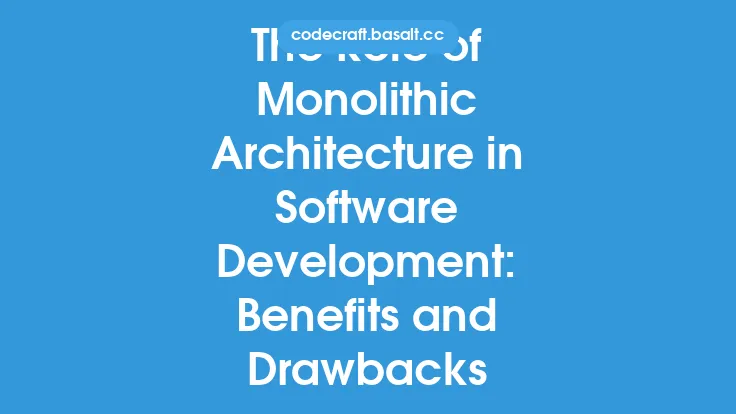In recent years, the software development industry has witnessed a significant shift towards microservices architecture, a design approach that structures an application as a collection of small, independent services. This paradigm has gained popularity due to its potential to enhance scalability, flexibility, and maintainability. However, like any other architectural style, microservices come with their own set of benefits and trade-offs. In this article, we will delve into the advantages and disadvantages of microservices architecture, discuss when to use it, and explore the key considerations for implementing this design approach.
Benefits of Microservices Architecture
Microservices architecture offers several benefits that make it an attractive choice for many organizations. One of the primary advantages is scalability. In a monolithic architecture, the entire application is built as a single unit, which can make it difficult to scale individual components. In contrast, microservices allow developers to scale specific services independently, ensuring that resources are allocated efficiently. This approach also enables flexibility, as each service can be developed, tested, and deployed separately, reducing the overall complexity of the application. Additionally, microservices promote resilience, as a failure in one service does not necessarily affect the entire application. Other benefits of microservices include easier maintenance, faster time-to-market, and improved fault isolation.
Trade-offs of Microservices Architecture
While microservices offer several advantages, they also come with some significant trade-offs. One of the primary challenges is increased complexity, as the application is broken down into multiple services that need to communicate with each other. This can lead to higher operational overhead, as developers need to manage multiple services, each with its own deployment, monitoring, and logging requirements. Another trade-off is distributed transactions, which can be challenging to manage in a microservices architecture. When multiple services are involved in a single transaction, ensuring data consistency and handling failures can become complex. Other trade-offs include higher communication overhead, potential for data inconsistencies, and increased security risks.
When to Use Microservices Architecture
So, when should you use microservices architecture? The answer depends on the specific requirements of your application and the needs of your organization. Microservices are a good fit for large, complex applications that require scalability, flexibility, and resilience. They are also suitable for applications with multiple, independent components, such as e-commerce platforms, social media sites, or online marketplaces. Additionally, microservices can be beneficial for organizations with multiple development teams, as each team can work on a separate service, reducing conflicts and improving overall productivity. However, for small, simple applications, a monolithic architecture may be more suitable, as it can be easier to develop, test, and maintain.
Key Considerations for Implementing Microservices
When implementing microservices architecture, there are several key considerations to keep in mind. First, define clear service boundaries, ensuring that each service has a well-defined responsibility and interface. Second, choose the right communication protocol, such as REST, gRPC, or message queues, depending on the specific requirements of your application. Third, implement service discovery and registration, to enable services to find and communicate with each other. Fourth, use containerization and orchestration tools, such as Docker and Kubernetes, to simplify deployment and management. Finally, monitor and log services, to ensure that you can detect and respond to issues quickly.
Best Practices for Microservices Development
To get the most out of microservices architecture, it's essential to follow best practices for development. First, keep services small and focused, ensuring that each service has a single responsibility and is easy to maintain. Second, use APIs and contracts, to define clear interfaces and ensure that services can communicate with each other. Third, implement automated testing and deployment, to reduce the risk of errors and improve overall quality. Fourth, use continuous integration and delivery, to ensure that services are built, tested, and deployed quickly and reliably. Finally, monitor and analyze service performance, to identify areas for improvement and optimize the application.
Conclusion
In conclusion, microservices architecture offers several benefits, including scalability, flexibility, and resilience. However, it also comes with trade-offs, such as increased complexity and higher operational overhead. To determine whether microservices are right for your application, consider the specific requirements and needs of your organization. By following best practices for development and implementation, you can ensure that your microservices-based application is scalable, maintainable, and reliable. Remember to define clear service boundaries, choose the right communication protocol, and implement service discovery and registration. With careful planning and execution, microservices architecture can help you build a robust, efficient, and scalable application that meets the needs of your users.





